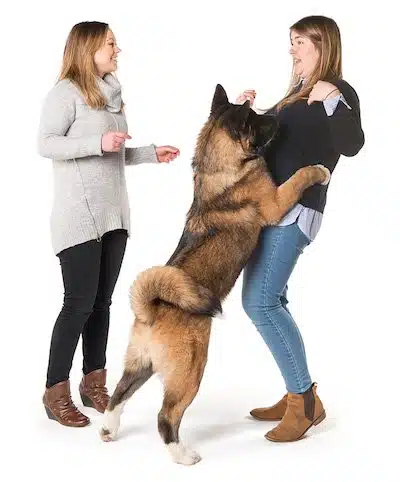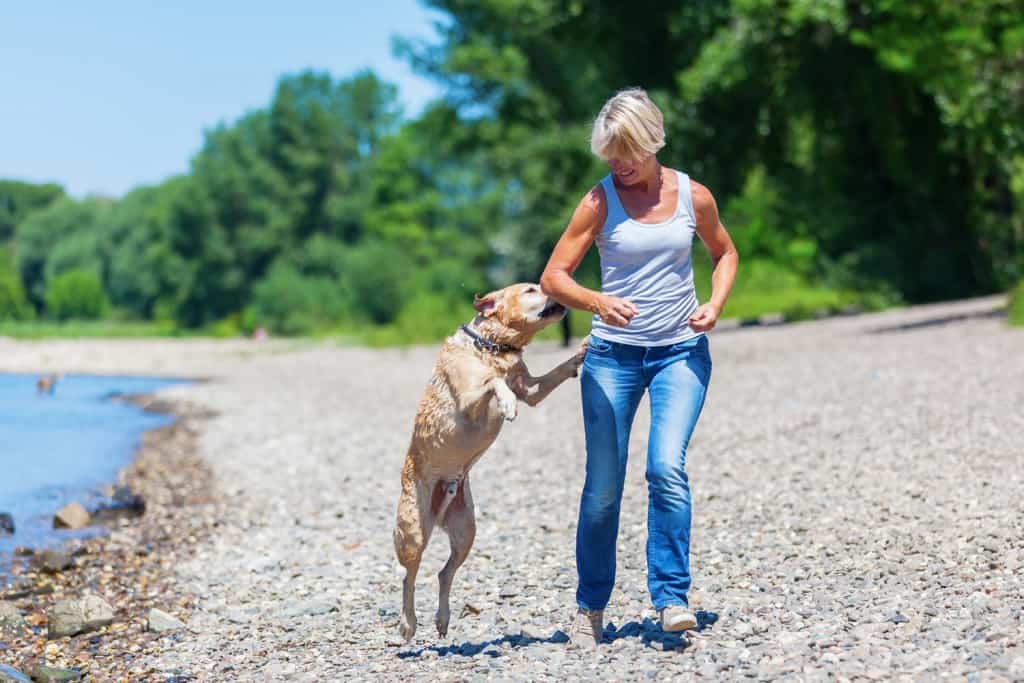How to Stop Dog Jumping and Biting? Our canine companions are bundles of joy, but sometimes their exuberance can lead to jumping and playful nipping. While these behaviors are natural, they can become problematic if left unaddressed.
Table of Contents
In this definitive guide, we’ll explore why dogs exhibit these behaviors, the importance of correcting them, and how to establish a well-behaved and controlled dog-human interaction.
Why Do Dogs Jump and Bite When Excited?

When Fido greets you with joyful leaps and nips, it’s essential to understand the reasons behind these actions:
- Social Interaction: Jumping is a dog’s way of saying, “Hello, I’m thrilled to see you!” It’s a form of social interaction.
- Playfulness: Dogs explore their world through their mouths. Playful nipping is common during puppyhood and high-energy play sessions.
- Excess Energy: Excitement often stems from pent-up energy. Jumping and biting provide an outlet.
Calming an Excited Dog
Calming an excited dog requires patience and consistent effort. Here’s how to do it:
- Engage in Calming Activities:
- Before situations that typically trigger excitement (like guests arriving), engage your dog in calming activities. Slow walks or gentle play can help reduce excess energy.
- Reward calm behavior with treats and praise.
- Set Clear Boundaries:
- Consistency is key. Establish rules about jumping and biting and enforce them consistently.
- Avoid overstimulating play that encourages jumping and biting.
Also Read: Seizures in Dogs: Exploring Root Causes, Recognizing Symptoms, and Optimal Treatment
Stopping a Dog From Jumping and Biting
Follow these structured training steps to stop your dog from jumping and biting:
- Basic Commands:
- Teach your dog basic commands like “sit” and “stay.”
- When your dog starts getting excited, calmly give the command to “sit.” Reward them with treats and praise when they obey.
- Repeat consistently, especially in situations that trigger their excitement.
- Redirect Biting:
- When your dog tries to bite, redirect their attention to an appropriate chew toy.
- This teaches them that calm behavior is rewarded and provides an outlet for their excitement.
Remember, addressing the underlying causes (such as overexcitement or lack of socialization) is crucial for lasting changes. With patience, positive reinforcement, and consistent training, you can help your dog become a well-behaved companion.
Understanding Why Dogs Jump and Bite When Excited
Before we delve into training techniques, it’s essential to grasp the reasons behind this behavior:
- Overstimulation: When a dog becomes overly excited, they may jump and bite as a way to express their enthusiasm. Recognize that this behavior often stems from affection or playfulness, not aggression.
- Lack of Training: Dogs need guidance on appropriately managing their excitement. Without proper training, they resort to jumping and biting.
Calming an Excited Dog
Calming an excited dog requires patience and consistent efforts. Here’s how to do it:
- Engage in Calming Activities:
- Before situations that typically trigger excitement (like guests arriving), engage your dog in calming activities. Slow walks or gentle play can help reduce excess energy.
- Reward calm behavior with treats and praise.
- Set Clear Boundaries:
- Consistency is key. Establish rules about jumping and biting and enforce them consistently.
- Avoid overstimulating play that encourages jumping and biting.
Stopping a Dog From Jumping and Biting
Follow these structured training steps to stop your dog from jumping and biting:
- Basic Commands:
- Teach your dog basic commands like “sit” and “stay.”
- When your dog starts getting excited, calmly command “sit.” Reward them with treats and praise when they obey.
- Repeat consistently, especially in situations that trigger their excitement.
- Redirect Biting:
- When your dog tries to bite, redirect their attention to an appropriate chew toy.
- This teaches them that calm behavior is rewarded and provides an outlet for their excitement.
Remember, addressing the underlying causes (such as overexcitement or lack of socialization) is crucial for lasting changes. With patience, positive reinforcement, and consistent training, you can help your dog become a well-behaved companion.
Advanced Techniques to Stop Dog Jumping and Biting When Excited
1. Desensitization: Slowly Introduce Exciting Situations
- Gradually expose your dog to situations that trigger excitement. For example:
- If your dog jumps when guests arrive, practice controlled introductions.
- Start with low-key visitors and gradually increase the excitement level.
- Reward calm behavior during these interactions.
2. Counterconditioning: Associate Excitement with Calm Behaviors
- Teach your dog that excitement leads to positive, calm outcomes:
- When your dog starts getting excited, redirect their focus.
- Use treats, praise, and gentle petting to reinforce calmness.
- Over time, they’ll associate excitement with pleasant experiences.
3. Response Substitution: Redirect Energy into Non-Aggressive Activities
- Provide alternative outlets for your dog’s excited energy:
- Offer chew toys or engage in interactive play.
- Teach commands like “sit” or “down” to redirect their energy.
- Consistently reinforce non-aggressive behaviors.
4. Avoid Overstimulating Situations
- Be mindful of scenarios that trigger excessive excitement:
- Manage playtime and interactions with others.
- Create a calm environment when needed (e.g., a quiet space or crate).
Remember, addressing the underlying causes (such as overexcitement or lack of socialization) is crucial for lasting changes. With patience, positive reinforcement, and consistent training, you can help your dog become a well-behaved companion.
Conclusion
Effectively curbing jumping and biting when excited requires a combination of training methods, consistency, and patience. Remember that every dog is unique, so adapt these strategies to your specific situation. If the issue persists, seek professional guidance to ensure a harmonious relationship with your furry friend.

